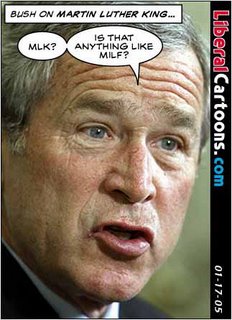
Bush PR costs taxpayers $1.6 billion
- Jennifer A. Dlouhy, Hearst Newspapers
Tuesday, February 14, 2006
Washington -- The Bush administration spent at least $1.6 billion on public relations and advertising campaigns over 30 months, according to a report released Monday by the Government Accountability Office, the investigative arm of Congress.
The report, requested by congressional Democrats, shows that government agencies are relying on outside consultants to help pitch their messages to the public, whether it's to bolster public support for the war in Iraq, deter buying prescription drugs from Canada or recruit for the armed forces.
"To communicate these messages to the general public or particular target audiences, departments contract with media-related vendors ... for a wide range of services, including communication plans, marketing design strategies, public relations campaigns, public service announcements and educational materials," according to the report.
Democrats complained that the White House was using propaganda to spin the public its way on the war on terror and other initiatives.
"No amount of money will successfully sell the Bush administration's failed policies, from the war in Iraq to its disastrous energy policy to its confusing Medicare prescription drug benefits," said Rep. Nancy Pelosi of San Francisco, leader of the House Democrats, who criticized what she called the White House PR machine.
The White House did not return calls for comment Monday, but the Education Department in the past has defended its public relations spending as a legitimate way to disseminate information to the public.
The GAO report did not single out any project for special attention but, in a separate study a year ago, the agency said the Bush administration had illegally engaged in covert propaganda for paying conservative commentator Armstrong Williams to praise the No Child Left Behind Act, the 2002 education law, in newspaper columns and on television.
The Bush administration also was rapped for issuing prepackaged "video news releases" that touted administration initiatives to broadcast media outlets, some of which aired the programs without disclosing their source.
Government auditors studied the spending by seven different cabinet-level departments for 30 months covering all of fiscal 2003 and 2004 and the first half of fiscal 2005. They focused on government contracts with public relations firms, advertising agencies and media organizations -- anyone the GAO said would "create (or) distribute content through various outlets, such as radio, television (and) newspapers."
Using federal procurement data, the government auditors found spending over two and a half years on 343 media contracts. The vast majority of the contracts were with advertising agencies.
For instance:
-- The Army paid $2.5 million to develop a plan to present its "strategic perspective in the global war on terrorism."
-- The Department of Health and Human Services paid $29,900 in 2004 and 2003 to an advertising agency to convince Americans that buying prescription drugs from Canada and other countries is risky.
-- The government spent $116,088 over two years for a "Be Whale Wise" campaign -- complete with billboards and radio advertising -- to educate residents of Seattle and Tacoma, Wash., about how recreational boating was dangerous to marine mammals in Puget Sound.
A private group that watches government spending said that while the report covers plenty of legitimate public relations spending, some of the costs should raise eyebrows.
"People see (military) recruitment ads on TV all the time, and I don't think anyone objects to that," said Tom Schatz, president of Citizens Against Government Waste, a not-for-profit watchdog group. But targeted, specific programs deserve a closer look, Schatz said.
The Interior Department complained that a host of legitimate contracts had been swept into the report and inaccurately labeled as public relations spending. For instance, department officials said the GAO should not have included spending on brochures or exhibits at National Park Service visitor centers.
No other government departments responded to the report.
Page A - 11
URL: http://sfgate.com/cgi-bin/article.cgi?file=/chronicle/archive/2006/02/14/MNG2JH80H61.DTL
--------------------------------------------------------------------------------
©2006 San Francisco Chronicle


0 Comments:
Post a Comment
<< Home